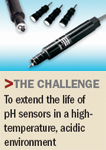Archer Daniels Midland Co. (ADM) makes ingredients for human food and animal feed, as well as renewable fuels and naturally derived alternatives to industrial chemicals. In 1971, ADM acquired Corn Sweeteners Inc., Cedar Rapids, Iowa, which it subsequently expanded into ethanol production.
Maintaining the correct pH level during ethanol manufacture is essential for controlling the sulfur dioxide concentration. But the pH sensors are required to do their work while immersed in a high-temperature, strongly acidic environment that reduces their lifetimes to a few days. Clearly, finding a sensor that would last for months would mean a welcome reduction in both equipment and labor costs.
 The Challenge |
Ethanol production involves fermenting and distilling starch and sugar crops. Liquefied starch is converted to dextrose and fermented. Yeast added to the mash converts the sugars to ethanol and carbon dioxide. The fermented mash, or "beer," contains about 11% alcohol, as well as all the nonfermentable solids from the corn and the yeast cells. The beer is heated to 235°F to evaporate the alcohol, which is then collected, condensed, and run through a rectifier to eliminate the remaining water. The final product is 199-proof, almost pure alcohol—ethanol.
"We tried taking pH readings directly from the process, but the 235°F temperature ate sensors up," says Lloyd Feickert, instrumentation supervisor at the Cedar Rapids facility. "To reduce excessive sensor costs we set up a slipstream arrangement, whereby we run a sample of the ethanol offline to cool it down to 140°F, and measure that."
Although the slipstream arrangement significantly extended sensor service life, process conditions still necessitated frequent replacement of components in the rebuildable sensors. "At the lower temperatures, pH sensors could last for weeks, but process conditions caused temperature fluctuations within the slipstreams. These reduced sensor life significantly. We had standardized on the Foxboro 871 rebuildable pH sensors, so we turned to them for the solution."
Foxboro worked with Feickert to develop a field-replaceable measuring electrode that could withstand severe temperature cycling up to 250°F. "I heard about the DolpHin line of high-temperature pH sensors and asked if a similar product could be developed for rebuildable sensors. They came up with a replaceable electrode that, after a cooperative testing period, increased our sensor service life from days to months," says Feickert.
The new electrode features a unique pH glass formulation that provides superior measurement stability, accuracy, and longer service in high-temperature applications. The glass also increases response speed up to 5 ×. The electrodes are available in domed, spherical, or ruggedized flat glass. The domed glass electrode is for temperatures up to 250°F and extremes of chemical concentrations. A plug-in design facilitates quick and easy replacement to address changes in measurement conditions.
According to Feickert, "Rebuildable sensors are definitely the most cost-effective way to measure pH for our applications . . . with the addition of the high-temperature domed electrode, we have all the tools to cost-effectively handle pH sensing throughout our plant. The 871PH electrode has increased pH sensor service life from 10 days to four months. When you consider that we use the domed sensor in four beer stills, as well as other processes within the plant, that's an enormous savings."
Also, as Feickert points out, "Every time you send a person out to work on a sensor, it's at least an hour's worth of labor. I estimate that we have reduced time spent on changing electrodes over the course of a year from 36 hours per electrode to three hours per electrode."
Contact John P. Connelly, Invensys Process Systems, Measurements and Instruments Div., Foxboro, MA; 508-549-4681, [email protected], www.foxboro.com/instrumentation.